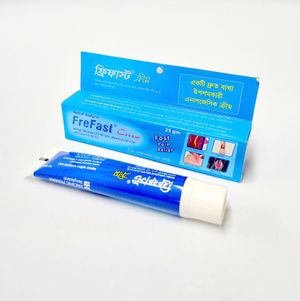Frefast Uses, Dosage, Side Effects and more
Methyl Salicylate:
Penetrates and reaches at high concentration in pain regionsInhibit the prostaglandin synthesis and relieves pain effectivelyMenthol:
Provides cooling sensation by stimulation of cooling receptorGives local anesthetic actionCamphor:

| Attribute | Details |
|---|---|
| Trade Name | Frefast |
| Generic | Methyl Salicylate + Menthol + Camphor |
| Weight | 30%+10%+4% |
| Type | Cream |
| Therapeutic Class | Topical anti-inflammatory preparations |
| Manufacturer | Pacific Pharmaceuticals Ltd |
| Available Country | Bangladesh |
| Last Updated: | January 7, 2025 at 1:49 am |
Uses
Provide symptomatic relief for mild to moderate muscular and joint aches and pains, muscle cramps, shoulder aches and stiff neck. For the temporary relief of pain associated with rheumatism, arthritis, neuralgia, sprains and strains of joints and muscles, lumbago and fibrositis
Frefast is also used to associated treatment for these conditions: Arthritis, Backache, Common Cold, Contusions, Inflammatory Reaction caused by Insect Bites, Joint Pain, Muscle Cramps, Nasal Congestion, Pain caused by Insect Bites, Rash, Skin Irritation, Soreness, Muscle, Sunburn, Swelling caused by Insect Bites, Minor burns, Neck or back pain, Shoulder acheAcute Muscle Pain, Arthritis, Back Pain Lower Back, Backache, Contusions, Joint Pain, Ligament pain, Muscle Inflammation, Muscle Injuries, Muscle Strain, Muscle swelling, Pain, Pain of the Bone and Bones, Pain, Nerve, Partial-Onset Seizures, Postherpetic Neuralgia, Soreness, Muscle, Sprains, Tendon pain, Minor aches, Muscle, joint pains
How Frefast works
Counter-irritation is thought to be effective at alleviating musculoskeletal pain as the irritation of the sensory nerve endings is thought to alter or offset pain in the underlying muscle or joints that are served by the same nerves . This is thought to mask the underlying musculoskeletal pain and discomfort. When applied topically, methyl salicylate is thought to penetrate the skin and underlying tissues where it reversibly inhibits cyclooxygenase enzyme and locally and peripherally prevents the production of inflammatory mediators such as prostaglandin and thromboxane A2.
Dosage
Adults and children 12 years of age and older: Apply on affected area not more than 3 to 4 times daily.
Children under 12 years of age: Use on advice of a doctor.
How Long Does It Take to Work?
How Long Does It Take to Work? see here Frefast
Side Effects
Stinging/ burning/ tingling sensation of skin. Redness or irritation may occur, especially in persons with sensitive skin. Adverse reactions possibly involved are mild to moderate local irritation, erythema, rash, desquamation, pruritis and relative local reaction at the application site.
Toxicity
Oral LD50 values (mg/kg) for mouse, rat and rabbit are 1110, 887 and 1300, respectively. Oral LD50 values for child and adult human (mg/kg) are 228 and 506, respectively. Although systemic toxicity from topical administration is rare, methyl salicylate can be absorbed in intract skin to cause stimulation of the central nervous system respiratory center, disturbance of lipid and carbohydrate metabolism, and disturbance of intracellular respiration. Severe toxicity can result in acute lung injury, lethargy, coma, seizures, cerebral edema, and death. In case of salicylate poisoning, the treatment consists of general supportive care, gastrointestinal decontamination with activated charcoal in cases of salicylate ingestion, and monitoring of serum salicylate concentrations. Bicarbonate infusions or hemodialysis can be used to achieve enhanced salicylate elimination .
Precaution
Avoid contact with the eyes and mucous membranes. Do not bandage tightly, wrap or cover until washing the area. It should not be applied to wounds or damaged skin. It should not be used immediately after bath. Wash hand thoroughly after applying.
Interaction
There are no known drug interactions and none well documented.
Volume of Distribution
After absorption, methyl salicylate is distributed throughout most body tissues and most transcellular fluids, primarily by pH dependent passive processes. Salicylate is actively transported by a low-capacity, saturable system out of the CSF across the choroid plexus. The drug readily crosses the placental barrier.
Elimination Route
Approximately 12-20% of topically applied methyl salicylate may be systemically absorbed through intact skin within 10 hours of application, and absorption varies with different conditions such as surface area and pH. Dermal bioavailability is in the range of 11.8 – 30.7%. For the assessment of potential oral exposure to salicylates, bioavailability is assumed to be 100% .
Half Life
The plasma half-life for salicylate is 2 to 3 hr in low doses and about 12 hr at usual anti-inflammatory doses. The half-life of salicylate may be as long as 15 to 30 hr at high therapeutic doses or when there is intoxication.
Elimination Route
Excreted by kidneys as free salicylic acid (10%), salicyluric acid (75%), salicylic phenolic (10%) and acyl glucuronide (5%), and gentisic acid (less than 1%).
Pregnancy & Breastfeeding use
Pregnancy Category C. Animal reproduction studies have shown an adverse effect on the fetus and there are no adequate and well-controlled studies in humans, but potential benefits may warrant use of the drug in pregnant women despite potential risks
Contraindication
Hypersensitivity to salicylate or any of its ingredients. Severe renal impairment.



